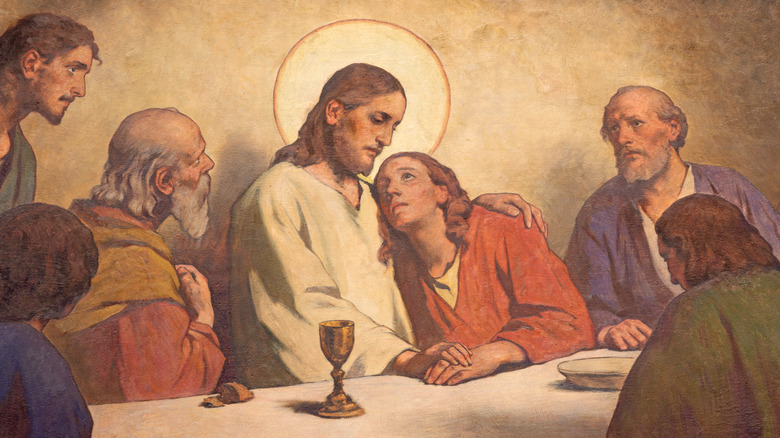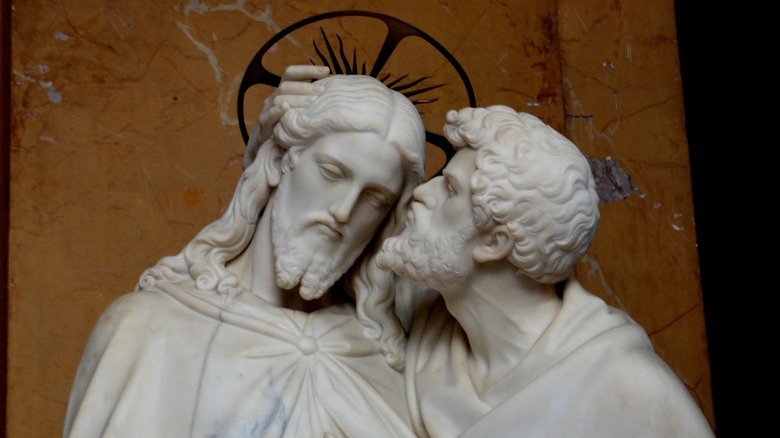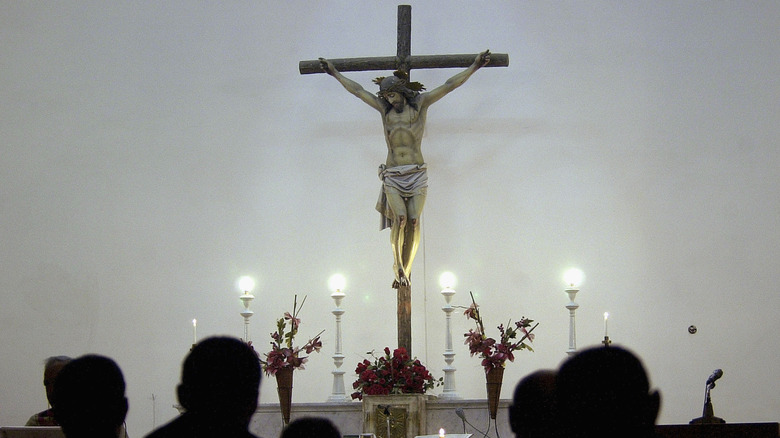The Gospel Of Judas Paints The Bible's Traitor In A Very Different Light
Without a doubt, Judas Iscariot is not only the most infamous traitor in the Bible, but possibly all of recorded history. As the Biblical story goes, he was a disciple of Jesus who handed his master over to Roman authorities for 30 silver coins, which directly caused Jesus' trial, crucifixion, and resurrection. Judas' very name is shorthand for "betrayer." As the University of Austin recounts, the famed Italian poet Dante Alighieri placed Judas in the deepest, ninth circle of hell in his 1314 epic poem "The Inferno," along with Gaius Cassius Longinus and Marcus Junius Brutus, the two chief conspirators who murdered the Roman dictator Julius Caesar. In the ninth circle of hell, all three men get eternally chewed in the maw of Satan. Not a good time.
In 2006, however, the public got its first look at a very different version of Judas. As National Geographic originally announced, a 1,800-year-old legend surfaced as fact: the Gospel of Judas. The ancient manuscript depicts a very different take on Christianity's most reviled individual, which we'll cover in this article. This article does not, however, exist to speak on behalf of — or against — religious doctrine. This article discusses how Judas, Jesus, and the rest of the disciplines come across in the Gospel of Judas per their words, actions, intentions, personalities, and so forth. It also examines the impact that the book has had on secular and religious worlds, and talks about similar non-canonical Biblical texts.
A 1,800-year-old legend made true
It took almost 1,800 years for the Gospel of Judas to change from legend into fact. St. Irenaeus of Lyons first mentioned the book back in 180 C.E. in his theological text "Against Heresies," written to formalize Christian doctrine in its early days. In book one, chapter 31 Irenaeus wrote about the "fictitious history" of writings related to the apostle Judas. These writings, he said, erroneously present Judas as being "thoroughly acquainted" with the nature of Sophia, a theologically non-canonical female angel-like entity representing wisdom. Irenaeus claimed that the Gospel of Judas was fraudulent because it said that "he [Judas] alone, knowing the truth as no others did, accomplished the mystery of the betrayal."
The Gospel of Judas remained a legend until the 1970s when an actual, physical copy emerged in Egypt written in Coptic, a language spoken by Egyptian Christians that borrowed the Greek alphabet for its written text. National Geographic says that the book passed to Rodolphe Kasser, a Swiss archaeologist and Coptic scholar who headed up the reconstruction and translation effort. It's likely that Gnostic Christians wrote the book, a branch of early Christianity that concerned itself more with Jewish mysticism than anything else, as PBS Frontline overviews. There's no unified Gnostic belief system or strict creed, just a collection of stories and texts like the Gospel of Judas that percolated their way to the present. Eventually National Geographic officially announced the book's finished reconstruction and English translation in 2006.
Different student, different master
Much of the Gospel of Judas consists of conversations between Jesus and Judas, where Jesus reveals to Judas the secrets of the cosmos. Readers of the book will immediately notice that it isn't Judas who stands out, but Jesus himself. Jesus comes across as a totally different person from the four Biblical gospels: strangely sarcastic, rude, pompous, and actually laughing at the "ignorance" of his disciplines, as verse 34 in the full text on Gospels.net says. He's more like Pai Mei from "Kill Bill" than a loving teacher, and also cryptic and unwilling to answer questions directly.
The cosmic secrets that Jesus tells Judas sound similar to the kind found in the apocryphal Pseudepigrapha and its mystical tales of King Solomon's magic, demon-controlling ring. Verse 50 of the Gospel of Judas begins, "Now the crowd of those immortals is called 'cosmos' — that is, 'perishable' — by the father and the seventy-two luminaries with the Self-Begotten and his seventy-two realms. That's where the first human appeared with his incorruptible powers."
Verse 51 describes the angel Eleleth emerging from a cloud of knowledge and summoning 12 other angels, including an angel of fire and blood called Nebro, aka Yaldaboath, whose name means "Rebel." Nebro conjures six other angels and "assistants," all of whom rule over Chaos and Hades (like from Greek myth). It's this council of angels who makes humanity "after the likeness and the image." Jesus also says that the archangel Michael "loan[s]" souls to humans.
Conversations with God
Judas, like Jesus himself, comes across as totally different in the Gospel of Judas. The Bible describes Judas in terms of his actions, not his personality, and his actions demonstrate cunning, treachery, and greed. The story is familiar to many and can be condensed to three bullet points: Judas decides to hand Jesus over to Roman authorities in exchange for 30 silver coins, shows the authorities which person Jesus is by kissing Jesus in the Garden of Gethsemane, and then once he realizes what he's done is stricken by guilt and hangs himself.
Things couldn't be more different in the Gospel of Judas, as the translation on Gospel.net reads. Verse 35 shows how Judas is the only one of Jesus' 12 disciplines to show proper respect to Jesus by not saying "God" out loud. Judas is eager to hear Jesus' explanation about cosmic mysteries, and eventually, Jesus pulls him aside and takes him on a little walk-and-talk. That's when Jesus goes through the whole, aforementioned explanation about angels, the creation of humanity, and the fate of the universe. Jesus doesn't talk about his plan for redeeming humanity in clear terms but in abstract ways. He shows favor to Judas, who demonstrates consistent humility, by saying that Judas' "star will [rule] over the thirteenth realm." Judas also receives a vision directly from God, although that part of the translation seems to have been corrupted. Eventually, the book ends when Roman authorities approach Judas like in the Biblical gospels.
The meaning of a kiss
Much has been written about the theological implications of the Gospel of Judas. There are straightforward analyses of the book (History), ardent supporters of it (The Not So Innocent Abroad), articles that demonstrate cautious curiosity (the North American Mission Board), and plenty of repudiations (Adventist Review, Got Questions, Evangelical Focus, and loads more). All such articles circle back to the central theological question that's probably bothered more than a few Christians for millennia: if Jesus knew what Judas would do, and Judas was acting in accordance with a predetermined redemption for humanity, then how much of a villain is he, really? Even in typical theological circles, Judas plays a needed role, much like Satan, without whom which there is no breaking of the original Biblical covenant with Adam and Eve, no free will, no reconciliation with God through the sacrifice of His son, etc.
The Gospel of Judas clears up all such lines of inquiry in one simple way: Judas was in on it. His kiss was a kiss of farewell, not betrayal. He was a willing scapegoat in the whole "save humanity" scheme acting under the express approval of Jesus. The Gospel of Judas portrays Judas as sacrificing himself for the cause and willingly adopting the scorn of the future. He's depicted as the only one of Jesus' disciples suited for this task, and the only one to whom the true workings of the cosmos are revealed. In other words, he's Jesus' favorite.
Authentically apocryphal
To the non-religious, the Gospel of Judas is just another non-canonical book of the Judeo-Christian lineage excluded from the compiled Christian Bible. There's a lot of these, to be clear, many of which are readable on InfoBooks. We've got Old Testament Apocrypha and New Testament Apocrypha. We've got Gnostic texts like the Gospel of Judas and non-Gnostic. We've got the formerly church-sanctioned Apocrypha that was actually included in the original 1611 King James Bible, like the books of Tobit, Esdras, Esther, The Wisdom of Solomon, Bel and the Dragon, and more, per the King James Bible Online. Meanwhile, other gospels include the Gospel of Mary Magdalene, the Gospel of Thomas, the Gospel of Ammonius, and books like the Epistle of Barnabas, the Apocalypse of Peter, the Shepherd of Hermas, and more.
Much like these other books, some question whether or not the Gospel of Judas is a forgery. Live Science goes into detail about the text's ink and papyrus, and how the papyrus warped and crinkled over time. The Gospel of Judas comes from Egypt, after all, the land of papyrus-making masters. Microscopist Joseph Barabe of McCrone Associates in Illinois confirmed its authenticity by comparing it to other Egyptian papyri in the Louvre and confirmed that it dates to the third century C.E., about 100 years after St. Irenaeus of Lyons first mentions it in 180 C.E. Believers and non-believers alike can take such facts into consideration when coming to their own conclusions about the text.





